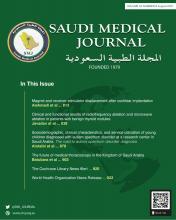Research ArticleOriginal Article
Open Access
Voiding dysfunction in children causes, management, and prognosis
A single-center retrospective study
Sherif M. El Desoky, Mai Banakhar, Khalid Khashoggi, Zaher F. Zaher and Jameela A. Kari
Saudi Medical Journal August 2021, 42 (8) 869-877; DOI: https://doi.org/10.15537/smj.2021.42.8.20210327
Sherif M. El Desoky
From the Department of Pediatrics (El Desoky, Zaher, Kari); from the Paediatric Nephrology Center of Excellence (El Desoky, Kari); from the Department of Urology (Banakhar); and from the Department of Radiology (Khashoggi), Faculty of Medicine, King Abdulaziz University, Jeddah, Kingdom of Saudi Arabia.
MD, MRCPCHMai Banakhar
From the Department of Pediatrics (El Desoky, Zaher, Kari); from the Paediatric Nephrology Center of Excellence (El Desoky, Kari); from the Department of Urology (Banakhar); and from the Department of Radiology (Khashoggi), Faculty of Medicine, King Abdulaziz University, Jeddah, Kingdom of Saudi Arabia.
MDKhalid Khashoggi
From the Department of Pediatrics (El Desoky, Zaher, Kari); from the Paediatric Nephrology Center of Excellence (El Desoky, Kari); from the Department of Urology (Banakhar); and from the Department of Radiology (Khashoggi), Faculty of Medicine, King Abdulaziz University, Jeddah, Kingdom of Saudi Arabia.
MD, FRCPCZaher F. Zaher
From the Department of Pediatrics (El Desoky, Zaher, Kari); from the Paediatric Nephrology Center of Excellence (El Desoky, Kari); from the Department of Urology (Banakhar); and from the Department of Radiology (Khashoggi), Faculty of Medicine, King Abdulaziz University, Jeddah, Kingdom of Saudi Arabia.
MDJameela A. Kari
From the Department of Pediatrics (El Desoky, Zaher, Kari); from the Paediatric Nephrology Center of Excellence (El Desoky, Kari); from the Department of Urology (Banakhar); and from the Department of Radiology (Khashoggi), Faculty of Medicine, King Abdulaziz University, Jeddah, Kingdom of Saudi Arabia.
MD, FRCP
References
- 1.↵
- 2.↵
- 3.↵
- 4.↵
- Chase J,
- Austin P,
- Hoebeke P,
- McKenna P.
- 5.↵
- 6.↵
- 7.↵
- Nevéus T,
- von Gontard A,
- Hoebeke P,
- Hjälmås K,
- Bauer S,
- Bower W, et al.
- 8.↵
- 9.↵
- Schwartz GJ,
- Muñoz A,
- Schneider MF,
- Mak RH,
- Kaskel F,
- Warady BA, et al.
- 10.↵
- 11.↵
- 12.↵
- Safdar OY,
- Al-Dabbagh AA,
- Abuelieneen WA,
- Kari JA.
- 13.↵
- Hinman F,
- Baumann FW.
- 14.↵
- Allen TD.
- 15.↵
- 16.↵
- 17.↵
- 18.↵
- 19.↵
- 20.↵
- 21.↵
- Maison POM,
- Lazarus J.
- 22.↵
- Lapides J,
- Diokno AC,
- Silber SJ,
- Lowe BS
- 23.↵
- 24.↵
- Bilgutay AN,
- Roth DR,
- Gonzales ET Jr.,
- Janzen N,
- Zhang W,
- Koh CJ, et al.
- 25.↵
- 26.↵
- Peters CA,
- Bolkier M,
- Bauer SB,
- Hendren WH,
- Colodny AH,
- Mandell J, et al.
- 27.↵
- Nasir AA,
- Ameh EA,
- Abdur-Rahman LO,
- Adeniran JO,
- Abraham MK.
- 28.↵
- 29.↵
- Mehmood S,
- Seyam R,
- Firdous S,
- Altaweel WM.
- 30.↵
- Husmann DA.
- 31.↵
- Marte A,
- Borrelli M,
- Prezioso M,
- Pintozzi L,
- Parmeggiani P.
- 32.↵
- Kari JA,
- El Desoky SM,
- Farag YM,
- Singh AK.
- 33.↵
- McLeod DJ,
- Szymanski KM,
- Gong E,
- Granberg C,
- Reddy P,
- Sebastião Y, et al.
- 34.↵
- Saeed B.
In this issue
Voiding dysfunction in children causes, management, and prognosis
Sherif M. El Desoky, Mai Banakhar, Khalid Khashoggi, Zaher F. Zaher, Jameela A. Kari
Saudi Medical Journal Aug 2021, 42 (8) 869-877; DOI: 10.15537/smj.2021.42.8.20210327
Jump to section
Related Articles
- No related articles found.
Cited By...
- No citing articles found.





